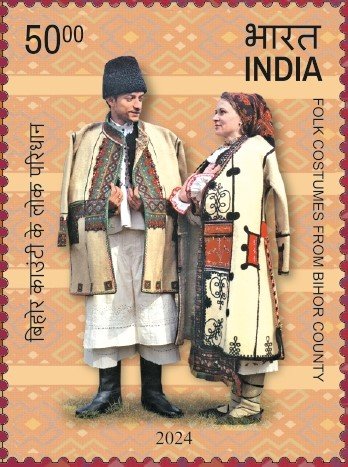Folk Costume of Bihor County, Romania

Technical Data
| Stamp Set | India-Romania Joint Issue : National Costumes |
|---|---|
| Date of Issue | September 14, 2024 |
| Denomination | Rs. 50 |
| Quantity | 113,700 |
| Perforation | Harrow14 |
| Printer | Security Printing Press, Hyderabad |
| Printing Process | Wet Offset |
| Watermark | No Watermark |
| Colors | Multicolor |
| Credit (Designed By) | Sh. Jairaj T.G. |
| Catalog Codes |
Colnect codes IN 2024.09.17-01b |
| Themes | Anniversaries and Jubilees | Diplomacy | Folklore | Joint Issues | Suits and Costumes |
A Symbol of Identity
The folk costume of Bihor County, Romania, is more than just attire—it is a cultural identity card, passed down through generations. Each detail reflects the traditions, craftsmanship, and way of life of rural communities in this historic region.
Vibrant Embroidery and Design
The costumes are distinguished by intricate embroidery in bold colors—red, green, and black—set against the purity of a white base fabric. These vibrant patterns not only add beauty but also symbolize strength, fertility, and harmony with nature.
Women’s Attire
For women, the traditional costume includes a white shirt richly embroidered with geometric and floral motifs. It is complemented by a long sheepskin coat, a practical yet decorative garment that reflects both artistry and utility. Women also wear a black kerchief adorned with red floral designs, symbolizing elegance and continuity of tradition.
Men’s Attire
The men’s costume is characterized by its simplicity and grace. A white embroidered shirt is paired with traditional trousers, while a plain black hat completes the attire, giving it a dignified and timeless appeal.
A Living Tradition
Beyond its aesthetic beauty, the folk costume of Bihor County represents the spirit of community life, festivals, and rural traditions. It continues to be worn on special occasions, keeping alive the values, skills, and cultural pride of the region.
First Day Cover


Leave a Comment
You must be logged in to post a comment.